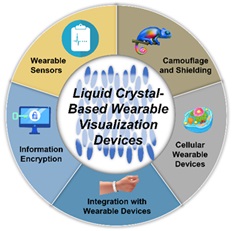Beyond displays: wearable liquid crystal devices for stimulus visualisation
Published 08 May, 2025
Portable, intuitive wearable devices have been sought after in recent years. Despite the flexibility and miniaturization of current electronic devices, the power supply and complex structural design of electronic devices affect their wearing comfort.
Liquid crystal material itself can serve both sensing and display functions without energy consumption. In a review published in the KeAi journal Wearable Electronics, a group of researchers from Tongji University in Shanghai outlines the applications of liquid crystal materials in the wearable field in recent years, particularly in information visualisation. These liquid crystal material-based devices are able to change the shape or color of the pattern upon exposure to external stimul, giving the wearer visible and intuitive information.
"We expect liquid crystal materials to create value again in new fields," says one of the study's authors, Yang Xu. "Liquid crystals are known for their responsiveness to stimuli; however, they are also highly processable and can be designed in different forms, allowing them to remain responsive while being flexible enough to serve the wearer.”
At the same time, the liquid crystal material itself is able to visualize the stimuli it senses, such as a change in color or shape, without the need for additional power supply and analysis equipment, which is also a major advantage in the wearable field."
In the review, the authors outline a variety of wearable devices based on liquid crystal materials, covering applications in wearable visualisation sensors, wearable camouflage and shielding, anti-counterfeiting and information encryption, cellular wearable devices and integration with other wearable devices.
“Liquid crystal materials act as a bridge to connect optical signals and stimuli, transforming the unseen and untouchable signals into intuitive optical signals,” adds Xu. “These portable and compact devices can get out of the lab and into daily life, which is the future direction of wearable devices. In the future, by designing their structures, we believe liquid crystal materials will be able to sense more complex signals and display more refined patterns, adding to our smart devices.

Contact author details: Yang Xu, School of Materials Science and Engineering, Tongji University, email:yxu@tongji.edu.cn
Funder: This research was supported from the National Key Research and Development Program of China (2021YFA1101303), the National Natural Science Foundation of China (62074111, 22105043, 22305175), the Innovation Program of Shanghai Municipal Education Commission (2021–01–07–00–07-E00096), and the Fundamental Research Funds for the Central Universities, with research conducted at Tongji University.
Conflict of interest: The authors declare that they have no known competing financial interests or personal relationships that could have appeared to influence the work reported in this paper.
See the article: C. Wu, Z. Lu, Y. Song, N. Li, Y. Xu, J. Huang. Wearable devices based on liquid crystal materials: Applications and challenges in visualisation, Wearable Electronics, 2, 85-99 (2025). https://doi.org/10.1016/j.wees.2025.03.001.